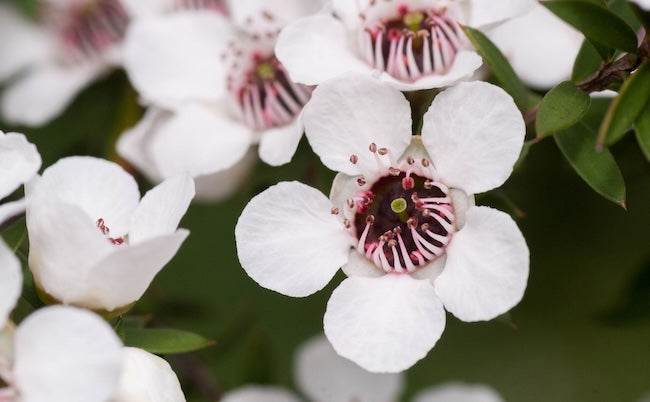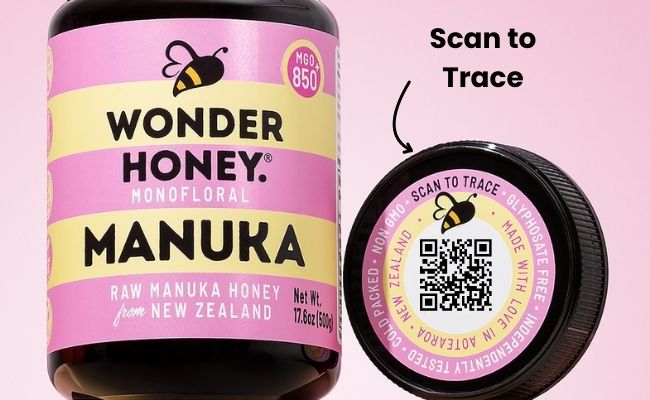One of the key components of Manuka Honey that contributes to its benefits is polyphenols, a diverse group of naturally occurring compounds found in plants. Polyphenols play crucial roles in plant physiology and are also significant for human health due to their biological activities.
Polyphenols are a category of phytochemicals characterized by the presence of multiple phenolic structures. They are abundant in fruits, vegetables, tea, and honey, and are known for their antioxidant, anti-inflammatory, and antimicrobial properties. Polyphenols play a crucial role in protecting the body against oxidative stress and chronic diseases.
Manuka honey is renowned for its high polyphenol content, which contributes to its antioxidant and antimicrobial properties. In a comparative analysis, Manuka honey exhibited a total Gallic acid content of about 2,500 mg GAE/kg and 35-38mg/kg of caffeic acid placing it as the highest out of 25 honeys with the highest polyphenol concentrations.
Key Polyphenols in Manuka Honey
-
Flavonoids :
- Flavonoids are a major subclass of polyphenols found in Manuka honey. They are known for their potent antioxidant properties and contribute to the honey's therapeutic effects.
-
Examples of Flavonoids in Manuka Honey :
-
Quercetin : This flavonoid is recognized for its strong antioxidant and anti-inflammatory properties. Quercetin may help reduce the risk of chronic diseases, support cardiovascular health, and enhance immune function.
-
Kaempferol : Another important flavonoid, kaempferol has been studied for its potential anticancer properties and ability to lower cholesterol levels.
-
Phenolic Acids :
- Phenolic acids are another significant group of polyphenols found in Manuka honey. They contribute to the honey's antioxidant capacity and have been associated with various health benefits.
-
Key Phenolic acids found in Manuka Honey
-
Dihydroxyacetone (DHA) :
- DHA is a unique compound found in high concentrations in Manuka honey. It is a precursor to methylglyoxal (MGO) and has been shown to possess antioxidant properties. DHA contributes to the overall antioxidant capacity of Manuka honey and may play a role in its therapeutic effects.
-
Other Polyphenols :
- Manuka honey also contains other polyphenolic compounds, such as 3-Phenyllactic acid and various flavonoids, which contribute to its health benefits and unique properties.
Health Benefits of Polyphenols in Manuka Honey
-
Antioxidant Activity :
- The polyphenols in Manuka honey are powerful antioxidants that help neutralize free radicals, reducing oxidative stress and protecting cells from damage. This protective effect is crucial for maintaining overall health and preventing chronic diseases.
-
Anti-Inflammatory Effects :
- Many polyphenols found in Manuka honey possess anti-inflammatory properties. By reducing inflammation, these compounds may help lower the risk of chronic inflammatory conditions, such as arthritis and allergies.
-
Antimicrobial Properties :
- The polyphenols in Manuka honey contribute to its antimicrobial activity, helping to inhibit the growth of various bacteria and fungi. This property makes Manuka honey a valuable natural remedy for wound healing and infection prevention.
-
Cardiovascular Health :
- The antioxidant and anti-inflammatory effects of polyphenols in Manuka honey may support cardiovascular health by improving blood circulation, reducing blood pressure, and lowering cholesterol levels.
Polyphenols are vital components of Manuka honey, contributing to its unique flavor, therapeutic properties, and health benefits. The combination of flavonoids, phenolic acids, and other bioactive compounds makes Manuka honey a powerful ally in promoting health and well-being. Incorporating Manuka honey into a balanced diet can support overall health and provide a natural source of antioxidants.
References
- Adams, C. J., et al. (2008). "Isolation by HPLC and characterisation of the bioactive fraction of New Zealand manuka (Leptospermum scoparium) honey." Journal of Antimicrobial Chemotherapy , 62(6), 1211-1217. Link to study
- Molan, P. C. (2001). "Why honey is effective as a medicine." Frontiers in Microbiology , 7, 569. Link to study
- K. M. M. Alzahrani, M. A. Farag, and M. A. El-Shafey. (2020). "Flavonoids in Manuka honey and their potential health benefits." Journal of Food Science and Technology , 57(4), 1450-1458. Link to study
- Kato, Y., et al. (2012). "Identification of a novel glycoside, leptosin, as a chemical marker of manuka honey." Journal of Agricultural and Food Chemistry , 60(34), 3418-3423. Link to study
- Al-Waili, N. S., et al. (2011). "Honey and microbial infections: A review supporting the use of honey for microbial control." Journal of Medicinal Food , 14(10), 1079-1096. Link to study
- Michał Gośliński, et al. (2021) "Multidimensional Comparative Analysis of Bioactive Phenolic Compounds of Honeys of Various Origin" Link to Study
- Michał Gośliński, et al. (2019) "Antioxidant properties and antimicrobial activity of manuka honey versus Polish honeys" Link to Study
<div class="dynamic-checkout__content" id="dynamic-checkout-cart" data-shopify="dynamic-checkout-cart"> <shopify-accelerated-checkout-cart wallet-configs="[{"name":"shop_pay","wallet_params":{"shopId":81423728939,"merchantName":"Wonder Honey","personalized":true}},{"name":"paypal","wallet_params":{"shopId":81423728939,"countryCode":"NZ","merchantName":"Wonder Honey","phoneRequired":true,"companyRequired":false,"shippingType":"shipping","shopifyPaymentsEnabled":true,"hasManagedSellingPlanState":null,"requiresBillingAgreement":false,"merchantId":"2GGQU7RZZH6TG","sdkUrl":"https://www.paypal.com/sdk/js?components=buttons\u0026commit=false\u0026currency=GBP\u0026locale=en_US\u0026client-id=AfUEYT7nO4BwZQERn9Vym5TbHAG08ptiKa9gm8OARBYgoqiAJIjllRjeIMI4g294KAH1JdTnkzubt1fr\u0026merchant-id=2GGQU7RZZH6TG\u0026intent=capture"}}]" access-token="132b5cac3bedfbcbd7438b6acfedfe5f" buyer-country="GB" buyer-locale="en" buyer-currency="GBP" shop-id="81423728939" cart-id="f65aedbb8434e51832a0d5b58a6b8b96" enabled-flags="["ae0f5bf6"]" > <div class="wallet-button-wrapper"> <ul class='wallet-cart-grid wallet-cart-grid--skeleton' role="list" data-shopify-buttoncontainer="true"> <li data-testid='grid-cell' class='wallet-cart-button-container'><div class='wallet-cart-button wallet-cart-button__skeleton' role='button' disabled aria-hidden='true'> </div></li><li data-testid='grid-cell' class='wallet-cart-button-container'><div class='wallet-cart-button wallet-cart-button__skeleton' role='button' disabled aria-hidden='true'> </div></li> </ul> </div> </shopify-accelerated-checkout-cart> <small id="shopify-buyer-consent" class="hidden" aria-hidden="true" data-consent-type="subscription"> One or more of the items in your cart is a recurring or deferred purchase. By continuing, I agree to the <span id="shopify-subscription-policy-button">cancellation policy</span> and authorize you to charge my payment method at the prices, frequency and dates listed on this page until my order is fulfilled or I cancel, if permitted. </small> </div>





